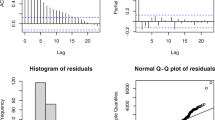Abstract
In the present paper, the theoretical background of multivariate autoregressive modelling (MAR) is explained. The motivation for MAR modelling is the need to study the linear relationships between signals. In biomedical engineering, MAR modelling is used especially in the analysis of cardiovascular dynamics and electroencephalographic signals, because it allows determination of physiologically relevant connections between the measured signals. In a MAR model, the value of each variable at each time instance is predicted from the values of the same series and those of all other time series. The number of past values used is called the model order. Because of the inter-signal connections, a MAR model can describe causality, delays, closed-loop effects and simultaneous phenomena. To provide a better insight into the subject matter, MAR modelling is here illustrated with a model between systolic blood pressure, RR interval and instantaneous lung volume.
Similar content being viewed by others
References
Takalo R, Hytti H, Ihalainen H. Tutorial on univariate autoregressive analysis. J Clin Monit Comput 2005; 19(6): 401–410.
Saarela O. Multivariate autoregressive analysis in locating the origin of fluctuation in continuous industrial processes. Thesis, Tampere University of Technology. Publications 2002; 366.
Oguma R. Investigation of power oscillation mechanisms based on noise analysis at Forsmark-1 BWR. Ann Nucl Energy 1996; 23(6): 469–485.
Rantala S, Jokinen H, Jokipii M, Saarela O, Suoranta R. Process dynamics study based on multivariate AR modelling. In: IECON'88 14th annual conference on IEEE Industrial Society, Singapore. 1988; Vol. 2, 320–325. IEEE.
Kaminski M, Liang H. Causal influence: Advances in neurosignal analysis. Crit Rev Biomed Eng 2005; 33(4): 347–430.
Korhonen I, Mainardi L, Loula P, Carraults G, Baselli G, Bianchi A. Linear multivariate models for physiological signal analysis: Theory. Comput Methods Programs Biomed 1996; 51: 85–94.
Korhonen I, Mainardi L, Baselli G, Bianchi A, Loula P, Carraults G. Linear multivariate models for physiological signal analysis: Applications. Comput Methods Programs Biomed 1996; 51: 121–130.
Bendat JS, Piersol AG. Random data – analysis and measurement procedures (2nd ed). John Wiley & Sons, 1986.
Marple SL. Digital spectral analysis with applications, Prentice Hall, Englewood Cliffs 1987.
Suoranta R. Analysis of linear systems applying multivariate autoregressive model. Thesis (Licentiate). Tampere University of Technology, 1990.
Kay SM. Modern spectral estimation: Theory and application, Prentice-Hall, Englewood Cliffs, NJ, 1988: 455–465.
Levinson N. The Wiener RMS (root-means-square) error criterion in filter design and prediction. J Math Phys 1947: 261–278.
Durbin J. The fitting of time series models. Rev Int Statist I. 1960: 233–244.
Whittle P. On the fitting of multivariable autoregressions, and the approximate canonical factorization of a spectral density matrix. Biometrika 1963; 50: 129–134.
Wiggins R, Robinson EA. Recursive solution to the multichannel filtering problem. J Geophys Res 1965; 70(8): 1885–1891.
Akaike H. A new look at the statistical model identification. IEEE Trans Aut Cont 1974; 19(6): 716–723.
Parzen E, An approach to time series modelling and forecasting illustrated by hourly electricity demands. Technical Report 37, Statistical Science Division, State University of New York, 1976.
Kailath T (ed.) Modern signal processing Hemisphere publishing corporation, 1985: 59–122.
Priestley MB. Spectral analysis and time series, Vol. 1 and 2, Academic Press, London, 1981: 655–726.
Oguma R. Method to evaluate signal transmission paths in dynamic systems and its application to reactor noise analysis. J Nucl Sci Technol 1981; 18(11): 835–844.
Ebert TJ, Smith JJ, Barney JA, Merrill DC, Smith GK. The use of thoracic impedance for determining thoracic blood volume changes in man. Aviat Space Environ Med 1986 57(1): 49–53.
Korhonen I. Takalo R, Turjanmaa V. Multivariate autoregressive model with immediate transfer paths for assessment of interactions between cardiopulmonary variability signals. Med Biol Eng Comput 1996; 34(3): 199–206.
Perrot MH, Cohen RJ. An efficient approach to ARMA modeling of biological systems with multiple inputs and delays. IEEE Trans Biomed Eng 1996; 43: 1–14.
Hyndman BW, Kitney RI, Sayers BM. Spontaneous rhythms in physiological control systems. Nature 1971; 232: 339–341.
Robbe HWJ, Mulder LJM, Ruddel H, Langewitz WA, Veldman JBP, Mulder G. Assessment of baroreceptor reflex sensitivity by means of spectral analysis. Hypertension 1987; 10: 538–543.
Ljung L. System identification: Theory for the user, 2nd. ed., Prentice-Hall, Upper Saddle River, 1999: 292–295.
Parati G, Saul JP, Castiglioni P. Assessing arterial baroreflex control of heart rate: New perspectives. J Hypertens 2004; 22: 1259–1263.
Author information
Authors and Affiliations
Corresponding author
Rights and permissions
About this article
Cite this article
Hytti, H., Takalo, R. & Ihalainen, H. Tutorial on Multivariate Autoregressive Modelling. J Clin Monit Comput 20, 101–108 (2006). https://doi.org/10.1007/s10877-006-9013-4
Received:
Accepted:
Published:
Issue Date:
DOI: https://doi.org/10.1007/s10877-006-9013-4




